MATH 501 Fall 2006 Exam 2 Explain your answers carefully.
advertisement
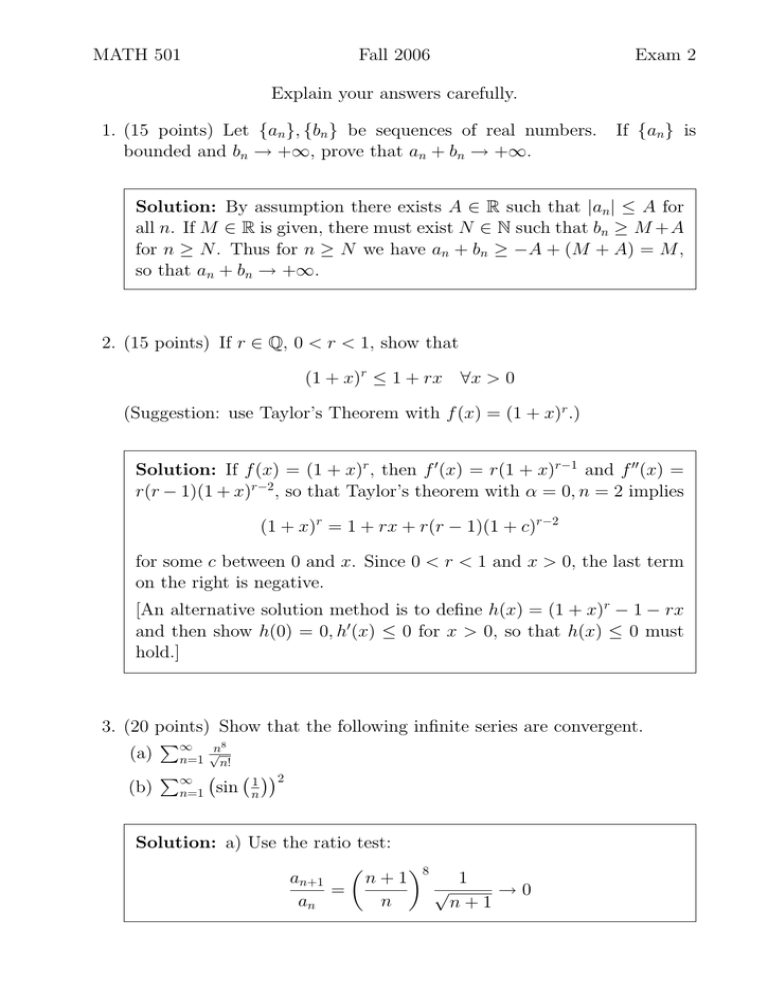
MATH 501
Fall 2006
Exam 2
Explain your answers carefully.
1. (15 points) Let {an }, {bn } be sequences of real numbers.
bounded and bn → +∞, prove that an + bn → +∞.
If {an } is
Solution: By assumption there exists A ∈ R such that |an | ≤ A for
all n. If M ∈ R is given, there must exist N ∈ N such that bn ≥ M +A
for n ≥ N . Thus for n ≥ N we have an + bn ≥ −A + (M + A) = M ,
so that an + bn → +∞.
2. (15 points) If r ∈ Q, 0 < r < 1, show that
(1 + x)r ≤ 1 + rx ∀x > 0
(Suggestion: use Taylor’s Theorem with f (x) = (1 + x)r .)
Solution: If f (x) = (1 + x)r , then f 0 (x) = r(1 + x)r−1 and f 00 (x) =
r(r − 1)(1 + x)r−2 , so that Taylor’s theorem with α = 0, n = 2 implies
(1 + x)r = 1 + rx + r(r − 1)(1 + c)r−2
for some c between 0 and x. Since 0 < r < 1 and x > 0, the last term
on the right is negative.
[An alternative solution method is to define h(x) = (1 + x)r − 1 − rx
and then show h(0) = 0, h0 (x) ≤ 0 for x > 0, so that h(x) ≤ 0 must
hold.]
3. (20 points) Show that the following infinite series are convergent.
P
n8
√
(a) ∞
n=1 n!
P
1 2
(b) ∞
sin
n=1
n
Solution: a) Use the ratio test:
8
an+1
n+1
1
√
=
→0
an
n
n+1
MATH 501
Fall 2006
Exam 2
b) Since | sin x| ≤ |x| for any x, it follows that
2
1
1
sin
≤ 2
n
n
so the series converges by the comparison test. [The limit comparison
(1/n)
→ 1.]
test could also be used, since sin1/n
4. (15 points) If f is continuous at x0 and f (x0 ) > 0, prove that there exist
, δ > 0 such that f (x) ≥ for |x − x0 | ≤ δ.
Solution: Corresponding to = f (x2 0 ) > 0 there exists δ > 0 such that
|f (x) − f (x0 )| < when |x − x0 | < δ. In particular f (x) − f (x0 ) > −
or f (x) > f (x0 ) − = whenever |x − x0 | < δ.
5. (15 points) In calculus class you learn that the minimum or maximum of
a continuous function f : [a, b] → R will be found at either
• a point of (a, b) where f 0 = 0, or
• a point of (a, b) where f is not differentiable, or
• one of the endpoints a, b.
Give a justification of this statement.
Solution: Since f is continuous on the compact interval [a, b] we know
that the maximum and minimum occur somewhere in [a, b]. If it is an
endpoint the statement is true. If not, it occurs at a point of (a, b).
If f 0 exists at this point then we know the derivative must be zero. If
not then f is not differentiable at the point. Thus one of the three
alternatives must hold.
[You could also say it this way: if none of the three conditions is
satisfied at x = c, then c ∈ (a, b), f 0 (c) exists and is not zero, from
which it follows as in the proof of Theorem 5.8 that c cannot be a local
minimum or maximum point.]
6. (20 points) Let x1 > 4 and xn+1 = 12 xn + 2 for n ≥ 1.
Page 2
MATH 501
Fall 2006
Exam 2
(a) Show that the sequence is monotonically decreasing and bounded
below.
(b) Conclude that the sequence is convergent and find the limit.
Solution: a) First we show that xn > 4 for all n: It is true by
assumption for n = 1, and if xn > 4 then
1
xn+1 = xn + 2 > 2 + 2 = 4
2
It follows that xn+1 ≤ xn because this is equivalent to 21 xn +2 < xn
which is equivalent to xn > 4.
b) Since xn in monotonically decreasing and bounded below it
follows that x = limn→∞ xn exists, and must satisfy x = 21 x + 2.
Thus xn → 4.
[An alternative way to show that the sequence is convergent is to
define en = xn − 4 and then calculate that en+1 = 21 en . It then
follows easily that en → 0 or xn → 4.]
Page 3
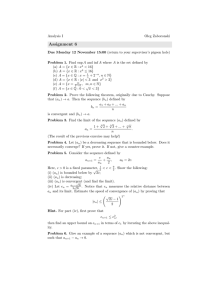

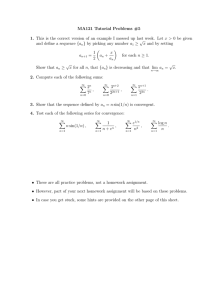

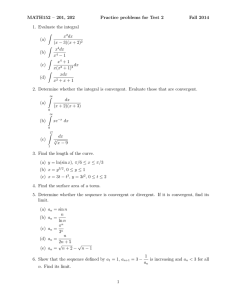
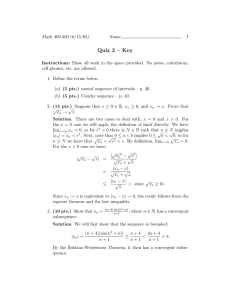


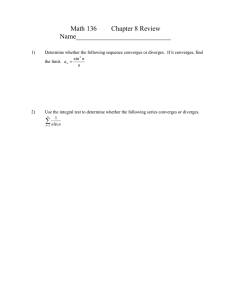
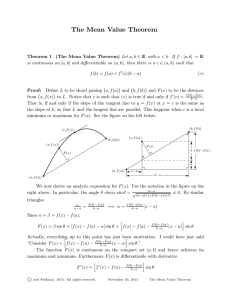
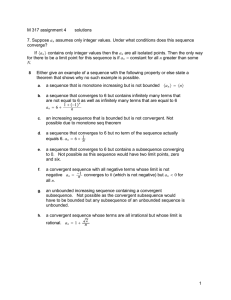
![Practice Problems 10 : Taylor`s Theorem 1. Let f : [a, b] → R and n be](http://s2.studylib.net/store/data/018039095_1-678f82dbdaadcfcdcb6058824c4705e9-300x300.png)